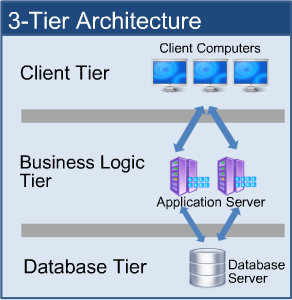Three Tier Architecture
The system is based on a three tier architecture which has been introduced by Sullivan (2003, Pg. 16) [2]. A three-tier architecture is a client-server architecture in which each layer is developed and maintained independently on a separate platform. Hence, replacement of a layer does not interfere with the functionalities of another layer.
Three-tier architecture is a software design pattern and a well-established software architecture. The application server hosts different modules ran by the graphical user interface. The relational database management system on the database server stores the data logic. Lastly, the middle tier is mostly divided in smaller operations.
The three tiers in a client-server architecture are analysed below:
Presentation Tier:
This is the first tier of the architecture and all the relevant information of provided functionalities are displayed here. The communication with the rest tiers is achieved through sending requests to the browsers, which include information of the results.
Application Tier:
The middle tier is also called the business logic of the software as it has the responsibility over the application’s functionality. Detailed processing is operated to guarantee the effectiveness of the system.
Data Tier:
The last tier hosts the database server where all the data is stored. The information of the server is not dependent on the middle tier.
[1] Blog.simcrest.com, ‘SimCrest – What is 3 tier Architecture: and Why do You need it’, 2015. [Online]. Available: http://blog.simcrest.com/what-is-3-tier-architecture-and-why-do-you-need-it/. [Accessed: 28- Apr- 2015].
[2]D. Sullivan, Proven portals best practices for planning, designing, and developing enterprise portals. Boston: Addison-Wesley, 2003.
[3] Techopedia.com, ‘What is Three-Tier Architecture? – Definition from Techopedia’, 2015. [Online]. Available: http://www.techopedia.com/definition/24649/three-tier-architecture. [Accessed: 28- Apr- 2015].



